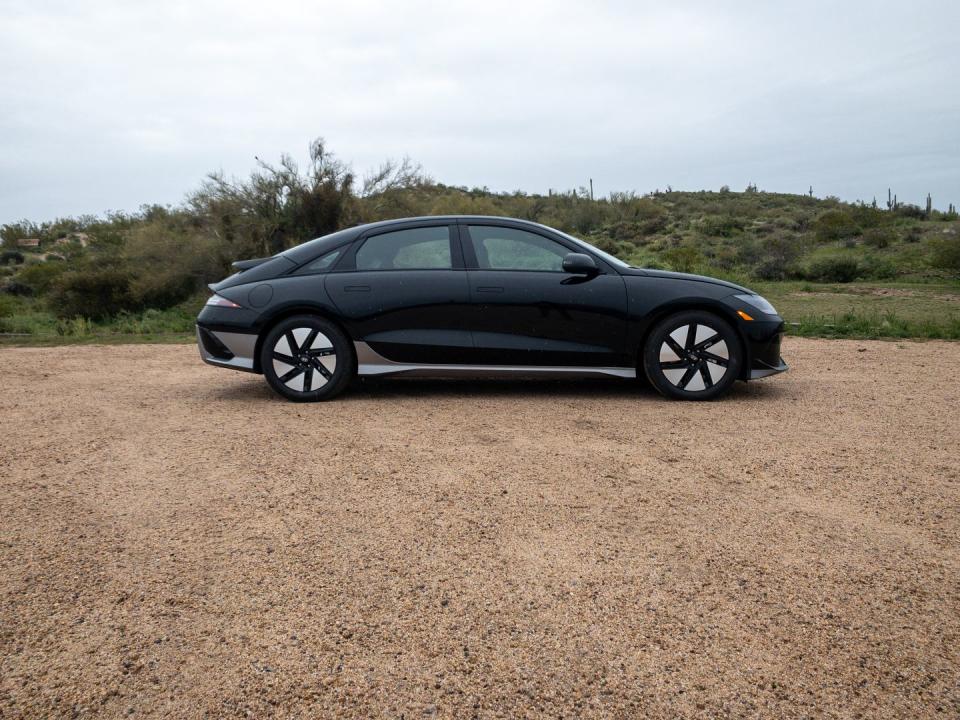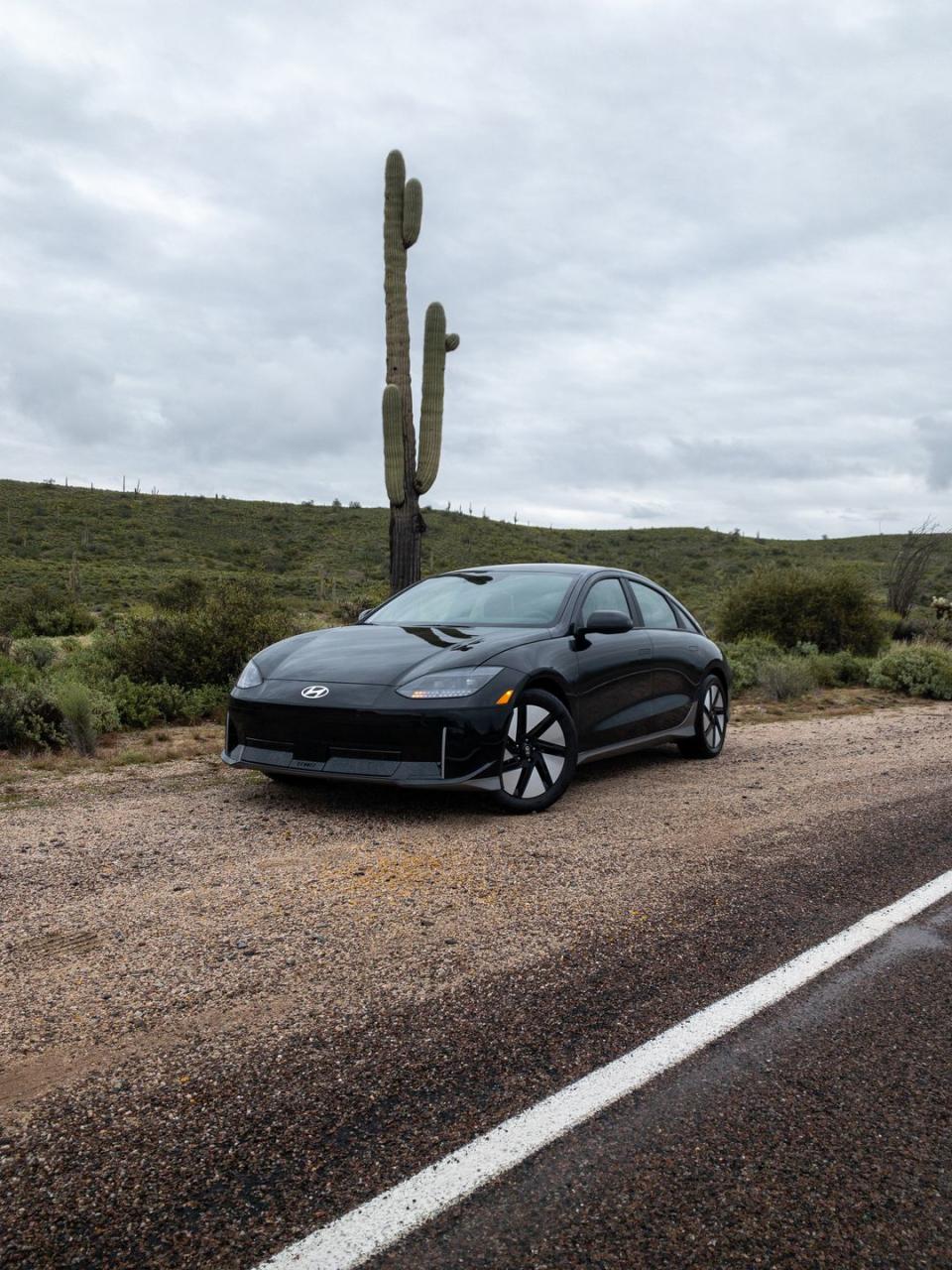The Hyundai Ioniq 6 Addresses Range Anxiety the Right Way

Even though EVs only accounted for 5.8 percent of U.S. car sales last year, a large chunk of the car-buying public is wondering if they can fit one in their lives. The biggest determinant, to most people, is range.
A good friend and fellow automotive reporter always says Americans buy a car for the worst day of the year. The day they have to move their two sons and all their things to college a couple hundred miles away, rather than the countless days they bop around town, existing within a 30-ish-mile radius. With an EV, everyone wants a big range figure for the handful of times they rack up big miles on the odometer. While we can debate the merits of this—and we should—for the purposes of this story, I'm just going to accept the American car buyer's demand for what it is. That's what automakers are doing as they enter the EV race, aiming for that seemingly elusive 300-mile figure.
The solution for many is more batteries. But, more batteries means more weight, and thus, less efficiency. Sure, compared to most internal-combustion only cars, an EV is more efficient, but a lot of these big-battery cars get combined miles-per-gallon equivalent (MPGe) scores that aren't much, if at all, better than plug-in hybrids. (The EPA considers a gallon of gas equivalent to 33.7 kWh of electricity.)

On the very extreme end of things, you get the GMC Hummer EV pickup, which has a 329-mile range from its 212-kWh pack—which, at 2932 pounds, weighs as much as a Honda Civic in and of itself—and gets an EPA combined rating of 47 MPGe. That puts it about on par with a Toyota Corolla Hybrid, but consider that the car you see here. The Hyundai Ioniq 6 SE Long-Range RWD manages to get 140 MPGe combined and 361 miles of range. It just goes to show how much potential we're wasting in the pursuit of more.
While the Ioniq 6's 77.4-kWh battery isn't tiny, it's not preposterously large either, and this car weighs in at around 4300 pounds. Hyundai is doing more with less. Being clever rather than using brute force to blow past the 300-mile mark.
A huge part of that is the Ioniq 6's extremely low drag factor. Per an interview with Hyundai design lead Simon Loasby, the Ioniq 6 draws inspiration from art-deco streamliners like the Stout Scarab, Phantom Corsair, and Saab's first prototypes. It's also easy to see shades of Hans Ledwinka's influential Tatras and the Porsche 356, while the spoiler on the leading edge of the trunk recalls that of many 911s.
Of course, it takes a lot more than aping the looks of old streamliners to make a car slippery. To that end, almost the entire underbody of the Ioniq 6 is covered, helping smooth out airflow. Active grille shutters direct air to the radiator when necessary, but otherwise stay closed, diverting air towards vents called "curtains" that keep the airflow attached around the front wheels. The wheels on the SE measure 18 inches compared with 20 inches elsewhere in the Ioniq 6 lineup, and are mostly flat to help airflow down the side of the car. Just below the taillights there's a little flow separation trap to help keep air attached around the rear of the car, and of course, there's the aforementioned trunk spoiler.

Those smaller wheels are also wrapped in smaller, lower-rolling resistance tires, a set of Hankook Ventus S2 all-seasons measuring 225/55R18. The drag coefficient is a remarkable 0.219, making it one of the most aero-efficient cars on sale today. The SEL and Limited use a wider, taller 245/40R20 Pirelli P-Zero All Season, which adds aerodynamic drag and rolling resistance. The drag coefficient for these higher-spec models goes up to 0.246 and range drops to 305 miles for rear-drive, 270 miles for all-wheel drive. (All-wheel drive models have a dog-clutch system to disengage the front motor when not in use, but there's still additional drag on the system, plus a lot of extra weight.)
In and around Phoenix, mainly on long straight roads in rainy mid-60-degree weather, the Ioniq 6 SE Long-Range RWD gave us no reason to doubt its ability to hit the 361-mile figure. Doing those sorts of roads, I saw efficiencies in the low 5-mile/kWh range, and after a spirited drive on a canyon road, that dropped to around 4.8 mi/kWh. In my personal experience, I've never seen anything close to this in an EV. Drive the Ioniq 6 carefully and at the right time of year, and I don't think it'd be too hard to achieve 400 miles.
When it arrives at dealers, the Ioniq 6 SE Long-Range RWD will tie the Lucid Air Pure and Touring for being the most efficient new car on the U.S. market. Both those versions of the Air offer more than 400 miles on a charge, but they use a larger 92-kWh battery. Plus, the Ioniq 6 costs about half as much as the cheapest Lucid, so it'll make a much bigger impact in the greater scheme of things, impressive though the Air is.

Let's consider the EPA's 33.7 kWh-of-electricity-equals-one-gallon-of-gas formula. That means that the Ioniq 6 SE Long-Range RWD can travel 361 miles on the equivalent energy of about 2.3 gallons of gas. Tesla has beaten the Ioniq 6's 140 MPGe combined, though with the old 142-MPGe Model 3 Long Range Plus RWD that's currently not available to order. Today, the best thing it'll sell you is a base Model 3 that does 132 MPGe.
If we must chase longer range for EVs—and it seems like we must—other automakers should follow the path taken by the Hyundai Ioniq 6. Find range by subtraction, not addition. Anything else just feels wasteful, and isn't that defeating the purpose of switching to EVs in the first place?
You Might Also Like

